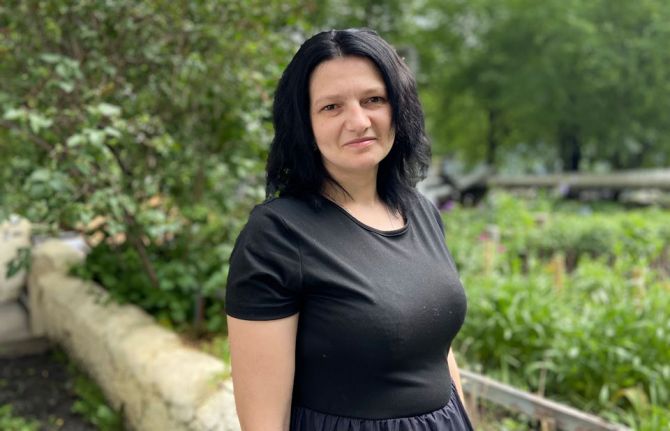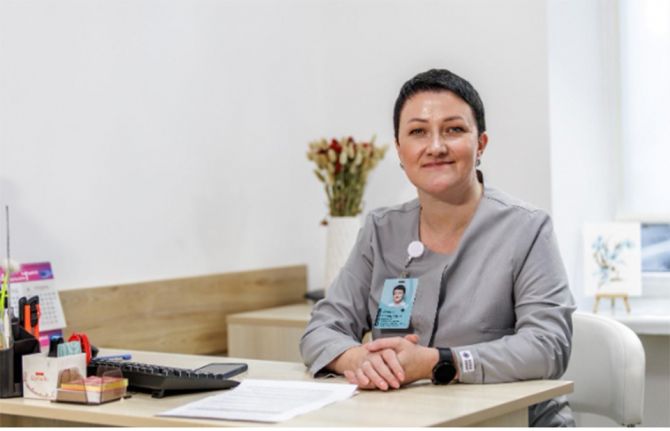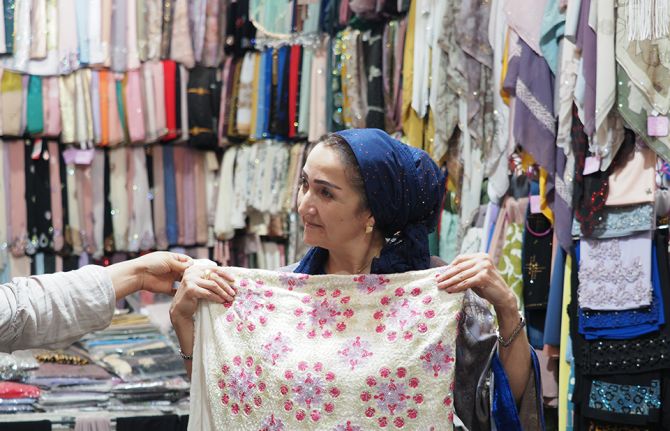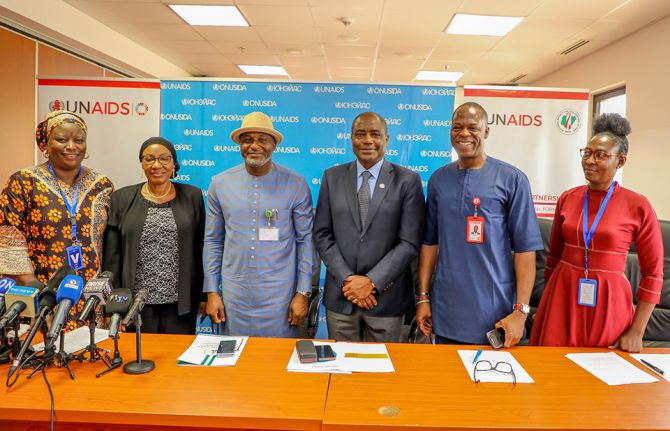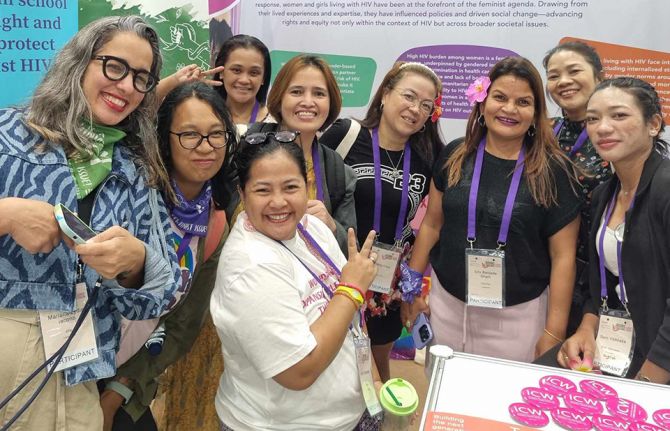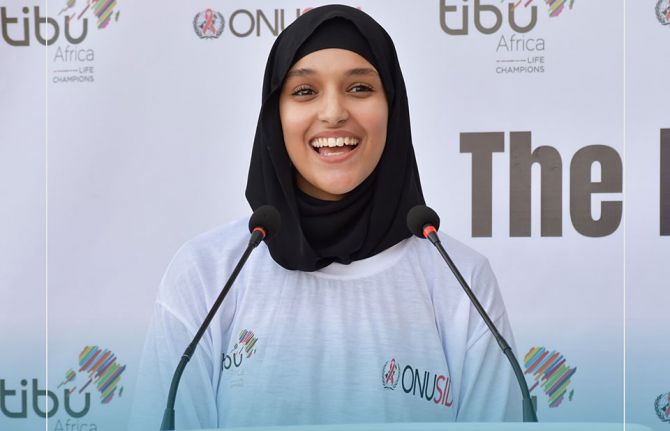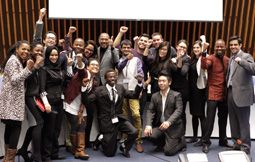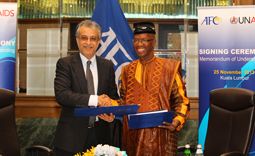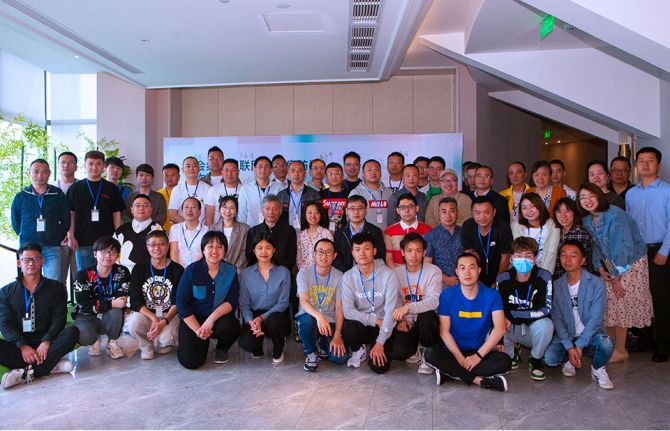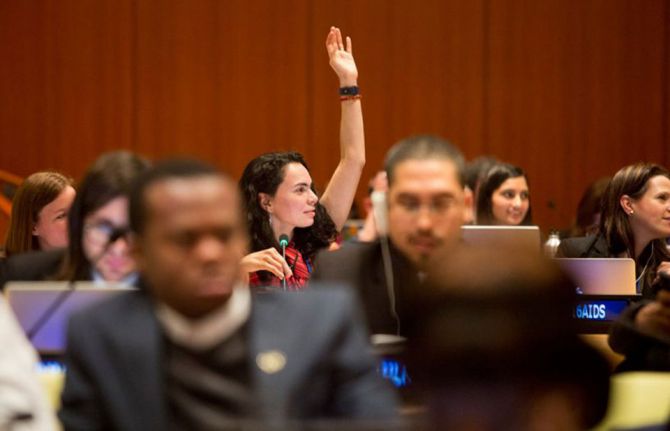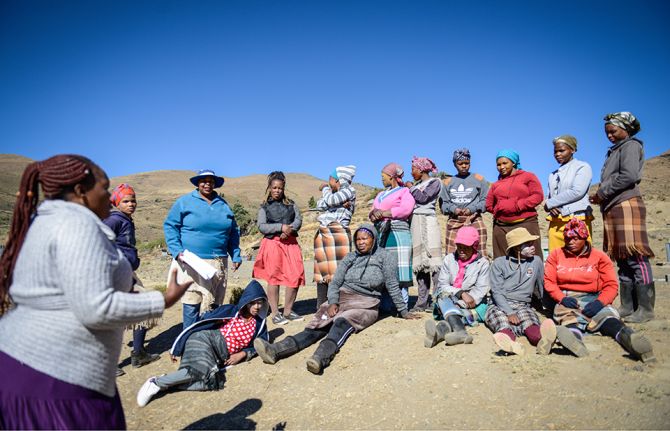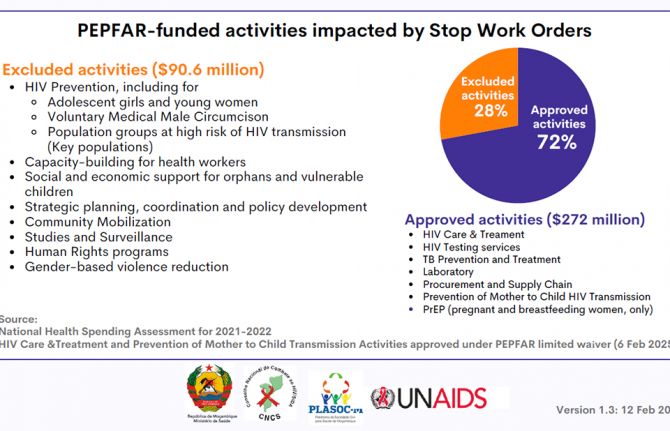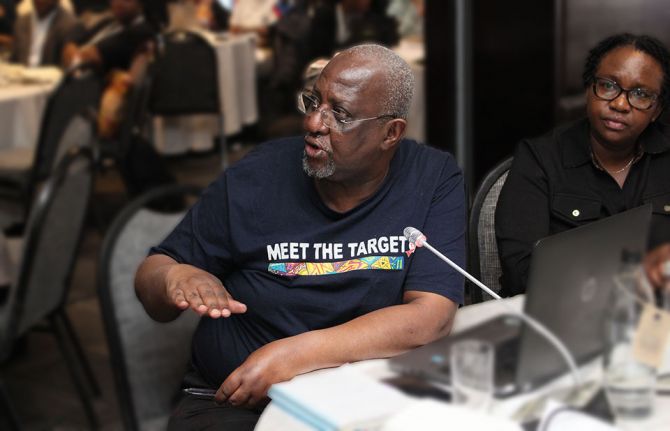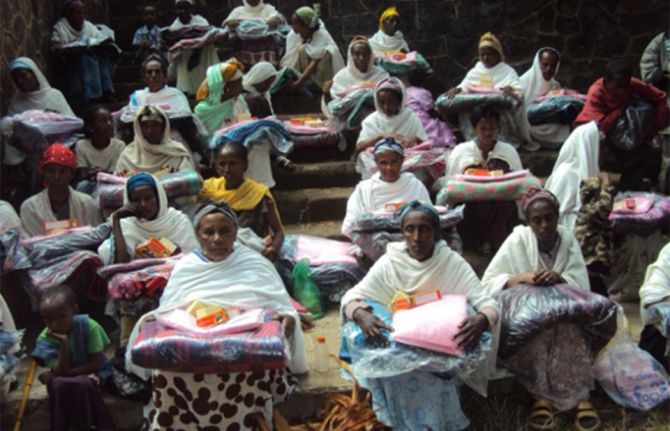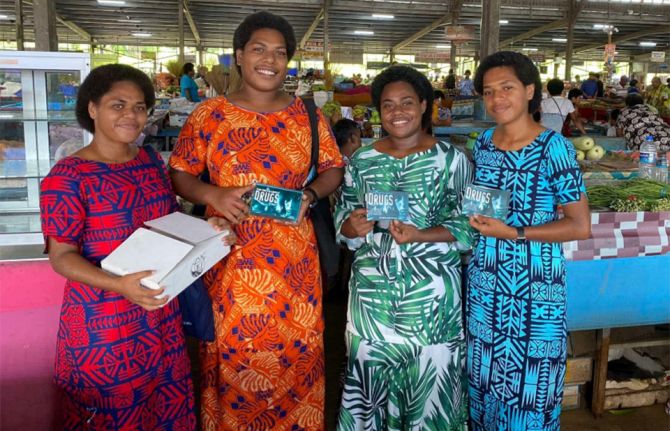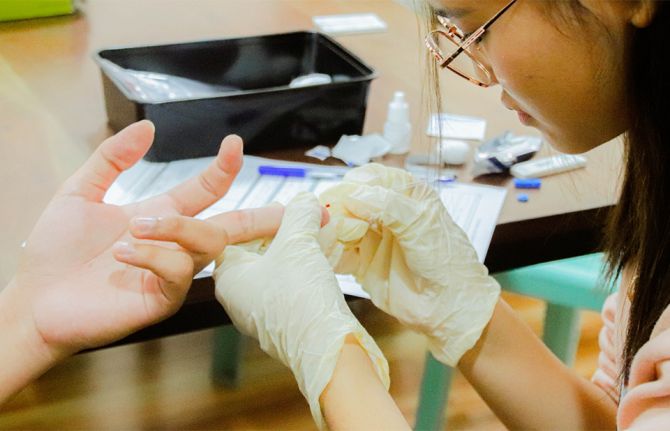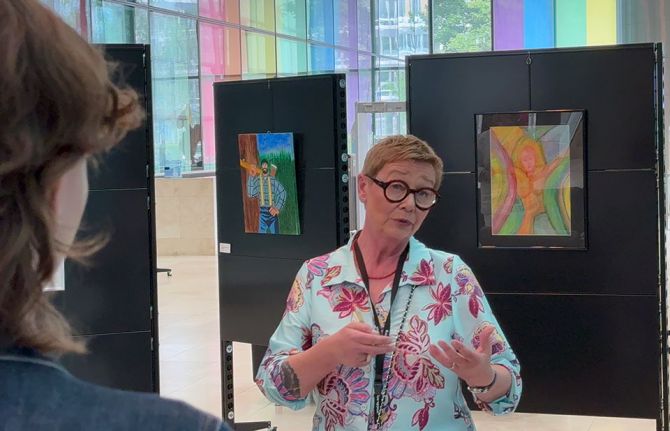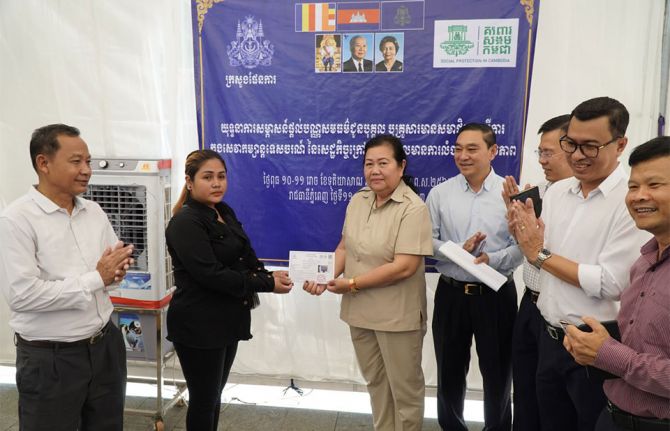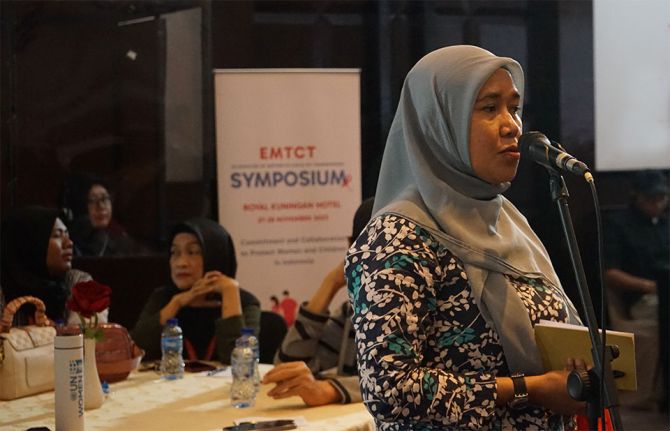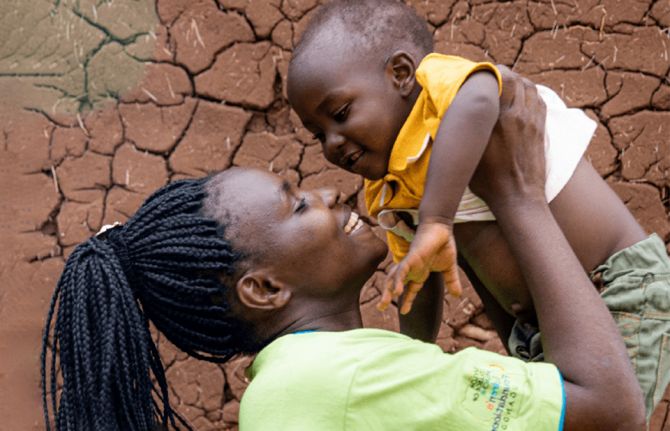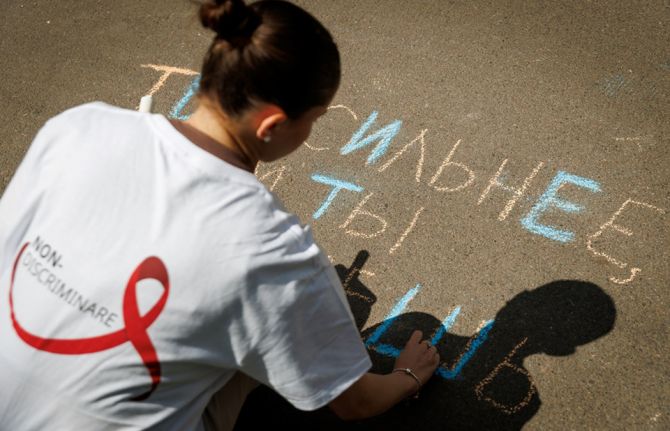
Feature Story
Photo exhibition captures Russia’s HIV epidemic
24 September 2010
24 September 2010 24 September 2010
Two students look at an image part of the joint Reuters and UNAIDS exhibition Time to Act, held at Moscow State University 21 September 2010. The exhibition was launched to coincide with the MDG Summit held at the United Nations in New York, 20-22 September 2010. UNAIDS\Kolomiiets
A new exhibition featuring images representing Russia’s HIV epidemic opened on 21 September at Moscow State University. The international news agency Reuters and the UNAIDS Regional Support Team for Eastern Europe and Central Asia partnered to display 35 of Reuters’ most compelling photographs.
Launched to coincide with the 20-22 September MDG Summit in New York, Time To Act gives a strong visual representation of the country’s epidemic. Its organizers hope the exhibition will provide visitors with an overview of the many sensitive issues facing Russia as it responds to its growing HIV epidemic.
Taken by seven photographers over the past 12 years, the photographs capture the scale and scope of the epidemic in Russia, from civil society protests and children orphaned by AIDS to the struggles encountered by key populations at higher risk.
Many of the images on display are striking but they communicate the reality of the challenges Russia and the Eastern European and Central Asia face in responding to HIV,” said Dr Denis Broun, Director of the UNAIDS Regional Support Team for the region. Information on HIV and how it is prevented should be provided coherently by health facilities, the media, schools and universities—this exhibition is a good example of making HIV awareness persuasive and informative.
The photographs are paired with statistics that provide information on the epidemic and its trends in the region. According to UNAIDS, an estimated 110 000 people were newly infected with HIV in the region in 2008, bringing the number of people living with HIV to 1.5 million.
“Young people and other visitors can’t stay indifferent after seeing the exhibition,” said Elena Vartanova, the Dean of Moscow State University’s Journalism Department, the host of the exhibition. “The images urge us to think and to take actions towards stopping the spread of the HIV epidemic.”
Time to Act runs until 29 October 2010.
Related

Feature Story
Sierra Leone wins MDG Award for AIDS response
23 September 2010
23 September 2010 23 September 2010
Sierra Leone's Foreign Minister Zainab Hawa Bangura at the 2010 MDG Award Ceremony, 19 September 2010.
At a ceremony on the eve of the 2010 Millennium Development Goals Summit, held in New York from 20-22 September, the Government of Sierra Leone was presented with an MDG Award for its leadership and progress towards achieving MDG 6, to stop and reverse the spread of HIV by 2015.
The MDG Awards Committee was impressed by Sierra Leone's efforts in developing an innovative and comprehensive national HIV strategy and, in particular, the high-level political commitment and involvement of Sierra Leone’s President, H.E. Ernest Bai Koroma, who chairs the country’s National AIDS Council (NAC).
Under the leadership of the NAC, the technical coordination of the National AIDS Secretariat and the engagement of multi-sector partners, Sierra Leone’s HIV prevalence has stabilized, as highlighted in UNAIDS’ special publication for the MDG Summit, MDG 6.
Partners credit a national commitment towards advancing the greater involvement of people living with HIV in the response and the scale up of HIV prevention, treatment, care and support services as key contributors to Sierra Leone’s progress on MDG 6.
“In a post-conflict country with a host of development challenges, the MDG Award is evidence of dedicated national leadership and true partnership,” said UNAIDS Country Coordinator, Mulunesh Tennagashaw. “The Award is an inspiration for all partners, and it will help drive us towards reaching greater results.”
With the development of a new National Strategic Plan on AIDS, the government has set its sights on zero new HIV infections by 2015.
The MDG Award was presented to Foreign Minister Zainab Hawa Bangura. The Awards are held annually to support and raise awareness of the MDGs by providing a high profile platform to honour and celebrate exemplary efforts by national governments and civil society stakeholders in advancing the achievement of the MDGs.

Feature Story
US$ 40 billion pledged for UN Secretary-General’s ‘Global Strategy for Women’s and Children’s Health’
22 September 2010
22 September 2010 22 September 2010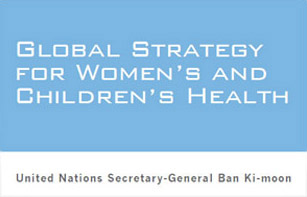
On the concluding day of the UN Millennium Development Goals Summit, United Nations Secretary-General Ban Ki-moon launched the Global Strategy for Women’s and Children’s Health, a concerted effort to save the lives of more than 16 million women and children.
In support of the Secretary-General’s new global strategy, foundations, civil society, private sector companies and other partners pledged more than US$ 40 billion in resources for women’s and children’s health.
“The 21st century must be and will be different for every woman and every child” said Secretary-General Ban in a press release announcing the strategy.
A high level panel was convened on 22 September to discuss the strategy. Participants included H.E. Wen Jiabao, Premier of China, H.E. Paul Kagame, President of Rwanda, H.E. Mizengo Pinda, Prime Minister of Tanzania, and H.E. Hillary Clinton, U.S. Secretary of State.
International organizations including UNAIDS, UNICEF, UNFPA, WHO and the World Bank were in attendance and are collaborating on a new initiative to mobilize political and operational support.
“I am committed to the Secretary-General’s strategy on women’s and children’s health—the response to his call is unprecedented,” said Mr Sidibé. “It is clear we must leverage investments in the HIV response to support progress across all the MDGs.”
The Global Strategy for Women’s and Children’s Health is a roadmap that identifies the financial and policy changes needed as well as critical interventions required to improve health and save lives.
The UN estimates that from 2011 to 2015 by implementing the Global Strategy many far-reaching gains will be made, from averting the deaths of 15 million children under five to preventing 740,000 women from dying of pregnancy and childbirth-related complications.
Read Press Release here.

Feature Story
UNDP: ‘AIDS and MDGs’ charting a way forward
22 September 2010
22 September 2010 22 September 2010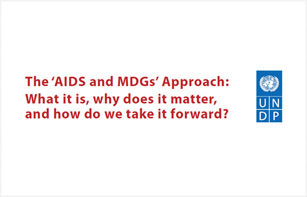
If the global HIV epidemic is to be curbed, links between HIV and reaching other Millennium Development Goals (MDGs) need to be explored, strengthened and leveraged. This is the key conclusion emerging from a new publication by the United Nations Development Programme (UNDP) released today at the UNAIDS hosted MDG Summit side event – AIDS plus MDGs: Delivering results towards our shared commitments.
The publication, The ‘AIDS and MDGs’ Approach: What is it, why does it matter and how do we take it forward?, highlights changes in the health and development landscape resulting in a need to re-think the relationship between HIV and the MDGs. This approach effectively addresses both the short- and long-term challenges and impacts of the HIV epidemic while promoting the attainment of wider health and development goals.
Drawing on recent research, programme experience, and country progress reports, the paper outlines three important elements: understanding how HIV and the other MDGs impact one another; exchanging programmatic lessons across HIV and the other MDGs; and, creating synergy and increasing cost-effectiveness through strategies that simultaneously address HIV and other MDGs.
“From the earliest days of the global AIDS epidemic, many have recognised that effective responses must combine biomedical and behavioural interventions with multi-sectoral strategies that address human rights and the underlying socio-economic conditions that shape vulnerability,” said Jeffrey O’Malley, Director of UNDP’s HIV/AIDS Practice.
“The MDG Summit signifies an exciting and historic opportunity to reaffirm commitments to address health and development together, and to exchange important lessons between the response to HIV and action to address other MDGs,” he said.
The report highlights case studies of how cross-MDG synergy can be promoted. For example, in Malawi’s Zomba district, the World Bank implemented a cash-transfer programme to encourage girls’ school attendance. A recent study showed a 60% decrease in HIV and other STI risk among participants. The girls were also more likely to stay in school, have a smaller age gap with male partners, and delay marriage.
The project demonstrates how leveraging the links between HIV and a range of other development issues can spur significant and accelerated progress towards multiple MDGs at once.
Related

Feature Story
UN Private Sector Forum convenes to fast track the MDGs
22 September 2010
22 September 2010 22 September 2010
Mr George Goldsmith, Chairman and Founder, Tapestry Networks, and Ms Jan Beagle, Deputy Executive Director Management and Programmes Branch, UNAIDS, 22 September, 2010.
Today 300 Heads of States and Governments, chief executives, civil society leaders and Heads of UN agencies participated in the United Nations Private Sector Forum on the Millennium Development Goals (MDGs), chaired by UN Secretary-General Ban Ki-moon.
The objective of the meeting was to identify concrete actions the private sector can take to help close MDG implementation gaps over the next five years. Among the topics addressed by the forum was maternal and child health and HIV, as well as empowering women and achieving equality.
“We depend on the resources and capacity of the private sector to achieve the Millennium Development Goals. The private sector has the lead on innovation,” said Secretary-General Ban Ki-moon.
Companies committed to conduct business in a responsible manner, aligned with fundamental environmental and social values and the Secretary-General called upon the private sector to invest in new and creative ways to capitalize on innovations, products and services to benefit the poor.
“UNAIDS strongly believes that without action to promote the rights of women and girls, the AIDS response has no hope of reversing the epidemic,” said Jan Beagle, UNAIDS Deputy Executive Director, Programmes and Management Branch.
“Governments, civil society and the private sector must come together to ensure that women and girls have universal access to HIV prevention, treatment, care and support,” she said. “We must have zero new infections, zero discrimination and zero AIDS related-deaths among women and girls.”
The United Nations is strengthening its capacity to engage and partner with the private sector. UN agencies, funds and programmes have a number of partnership opportunities for businesses to leverage their relative strengths, resources and competencies in support of achieving the MDGs.
Further information on these and other UN–business partnerships that could benefit from additional corporate engagement and support can be found at business.un.org.
Related

Feature Story
Financing the health-related MDGs
22 September 2010
22 September 2010 22 September 2010
UN Secretary-General Ban Ki-moon speaking at Global Fund Champions for Global Health session at UN MDG Summit 2010, New York. Credit: UNAIDS/Hamilton
On Tuesday 21st September, the Global Fund to Fight AIDS, Tuberculosis and Malaria organized an event entitled “Champions for Global Health - Financing the health related MDGs”. The meeting aimed at raising awareness among world leaders attending the MDG Summit as to the linkage between a fully-funded Global Fund and the achievement of the health related MDGs.
Meeting participants included Ministers from donor and recipient countries, leaders from the private sector, foundations, faith-based and international organizations.
“The Global Fund has emerged as the 21st century’s most powerful channel for health financing,” said UNAIDS Executive Director Michel Sidibé. “I am here to clearly demonstrate UNAIDS’ commitment to a fully funded Global Fund. However, the shared responsibility for ending the AIDS epidemic belongs to all of us—governments, civil society, the media, as well as committed individuals.”
2010 will be decisive for global health, because it is the year in which donor governments will commit funding to the Global Fund to cover programmes for 2011 to 2013. For that reason, the meeting provided a public platform for donor countries and private sector organizations to announce their pledges to the Global Fund in advance of its third replenishment meeting which will be held on 4 - 5 October in New York and will be chaired by the United Nations Secretary-General Ban Ki-moon.

Dr Margaret Chan, Director-General WHO and Michel Sidibé, UNAIDS Executive Director at the Global Fund Champions for Global Health session at UN MDG Summit 2010, New York. Credit: UNAIDS/Hamilton
It is estimated that nearly 2.8 million people are accessing treatment through funds provided by the Global Fund, more than half of the people on treatment today. However there are nearly 10 million people living with HIV who urgently need treatment. Five people are newly infected with HIV for every two people who newly access treatment.
New UNAIDS data show that new HIV infections have declined by more than 25% in 22 countries most affected by AIDS in sub-Saharan Africa. With nearly 5.2 million people on antiretroviral therapy, AIDS-related deaths have also fallen.
“Together, we can reach our goal if the Global Fund and its partners have enough resources to continue the dramatic progress that has been made in the response to AIDS in the past few years,” highlighted Mr Sidibé. He also noted that “If we are unable to provide the necessary resources, we could lose the tremendous gains we have made, and the inspiration and momentum for millions of people.”

Feature Story
High-level panel to discuss ‘AIDS plus MDG’ approach
22 September 2010
22 September 2010 22 September 2010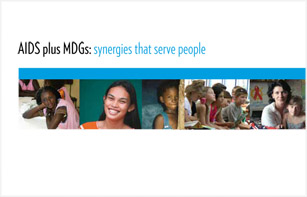
A global consensus is emerging that accelerated progress towards the Millennium Development Goals (MDGs) and more efficient use of resources can be achieved by taking the AIDS response out of isolation and integrating it with efforts to achieve other health and development goals.
On 22 September, the last day of the UN MDG Summit in New York, UNAIDS will co-host the event ‘AIDS plus MDGs: Delivering results towards our shared commitments’ together with the Governments of China, Ethiopia, Nigeria and South Africa.
Premier Wen Jiabao of China and Prime Minister Meles Zenawi of Ethiopia will be joined by Nigeria’s and South Africa’s Ministers of Health, Prof Onyebuchi Chukwu and Dr Aaron Motsoaledi, respectively, to generate political commitment to leverage the AIDS response to achieve the MDGs. Representing the United Nations will be UN Deputy Secretary-General Dr Asha-Rose Migiro, WHO Director-General Dr Margaret Chan, and UNAIDS Executive Director Mr Michel Sidibé, who will chair the event.
“World leaders and UNAIDS are joining together to give the message that we must invest strategically to address multiple MDGs,” said Mr Sidibé. “Releasing the power, capacity and innovation of the AIDS movement may provide one of the best opportunities to ‘do the MDGs’ differently.”
The relationship between AIDS and the MDGs is reciprocal: investments in the AIDS repose advance all the MDGs and efforts to meet the eight Goals address the social drivers of the HIV epidemic. To find out more about AIDS and the MDG, read the UNAIDS report AIDS plus MDGs: synergies that serve people, a report prepared by the Government of Ethiopia and a UNAIDS case study on Rwanda.

Feature Story
Addressing the special needs of the most vulnerable
21 September 2010
21 September 2010 21 September 2010
Addressing the special needs of the most vulnerable took centre stage at the 5th interactive round-table session organized in concurrence with the UN Summit held in New York, 20-22 September 2010.
According to the round-table participants, the most vulnerable countries and people are at risk of being left behind in achieving the Millennium Development Goals (MDG). They added that natural disasters, food and economic crises, poverty or armed conflict cause a disproportionate burden among the most vulnerable and are major challenges to achieving the Goals.
Participants emphasized the need for special assistance to help the most vulnerable countries achieve progress. And argued that addressing the special needs of vulnerable communities and people will help protect their basic human rights and ensure that they benefit from progress made in attaining the MDGs.
“Failure to reach vulnerable people is one of the greatest challenges we have in reducing new HIV infections” said UNAIDS Executive Director Michele Sidibé. “When the most vulnerable people are not able to access HIV services, it endangers the health and wellbeing of the entire community and it blocks progress toward every one of the MDGs,” he added.
While some countries have made notable progress towards meeting the MDGs, some gains have been undermined by the adverse impacts of natural disasters, climate change and the recent food, fuel and global economic and financial crises. Additional support from the international community was identified by the round-table as necessary to improve vulnerable countries’ ability to face such challenges.
Participants agreed that addressing the needs of vulnerable communities and people would involve: Strengthening national capacity to identify the most vulnerable in order to address their needs and protect their rights; establishing a social protection floor and increasing access to education and decent work; as well as implementing effective measures to combat all forms of discrimination and social exclusion.
Related

Feature Story
World leaders focus on the elimination of mother-to-child HIV transmission by 2015
21 September 2010
21 September 2010 21 September 2010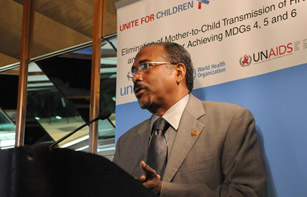
UNAIDS Executive Director Michel Sidibé speaks at UNICEF breakfast. 21 September 2010. Credit: UNAIDS/Hamilton
Virtual elimination of mother-to-child HIV transmission by 2015 and the linkages between Millennium Development Goals 4 (Reduce child mortality), 5 (Improve maternal health) and 6 (Combat HIV/AIDS, malaria and other diseases) were the focus of a working session that took place on Tuesday 21st September in New York as part of a MDGs Summit side event organized by UNICEF, WHO and UNAIDS.
“We must take AIDS out of isolation, leveraging investments in the global AIDS response to support progress across all other MDGs,” said UNAIDS Executive Director Michel Sidibé during his intervention.
Participants to the working session included high level country representatives, heads of international organizations, representatives of civil society and donor government delegates.
HIV remains a leading cause of death among women of reproductive age globally as well as of maternal mortality and under-five mortality in several countries. Although delivery of proven mother-to-child HIV transmission (MTCT) services has effectively eliminated MTCT in high-income countries, every day more than one thousand children in low-and middle income countries are newly infected with HIV via transmission during pregnancy, delivery, and breastfeeding.
Around 430,000 children are born with HIV each year and a new report released last week by WHO, UNICEF, UNFPA and the World Bank shows that despite the 35% decline in maternal morality worldwide since 1990, there has been setbacks in many sub-Saharan African countries, mainly as a result of HIV. In Botswana, maternal mortality rose 133% between 1990 and 2008, in South Africa 80%, and in Kenya 38%. In some countries, more than half of maternal mortality is attributable to HIV, e.g. Botswana (77%), Swaziland (75%), Lesotho (59%), Zimbabwe (53%), and South Africa (43%). These numbers underscore the indivisibility of the MDGs and highlight the links between MDG 5 and 6.
As participants stressed, there is strong consensus among the international community and national governments that scaling up prevention of mother-to-child HIV transmission (PMTCT) is feasible and needs to be accelerated.
UNAIDS identified PMTCT as one of the 10 outcome areas for joint action by the UN Co-sponsors. The UNAIDS Executive Director’s call for virtual elimination has become a rallying point for advocacy, resource mobilization and actions at all levels.
It was noted during the session that while many countries are now showing remarkable progress, intensified efforts are urgently needed to reach all mothers and children with PMTCT services.
Participants agreed that effectively eliminating MTCT will require sustained political leadership, country commitment, and donor support. Achieving the goal of MTCT elimination by 2015 also requires strengthening broader health systems and will both depend upon and contribute to achieving the Millennium Development Goals 4, 5, and 6.

Feature Story
MDGs Summit: Nigerian AIDS activist optimistic about success
21 September 2010
21 September 2010 21 September 2010
Lucy (standing) addresses the former First Lady of Nigeria Mrs. Turai Yar Adua during an advocacy visit by the Nigeria Task Team on prevention of mother-to-child transmission of HIV.
Lucy Attah has high hopes for this week’s Millennium Development Goals (MDGs) Summit. As a woman living with HIV and a gender activist from Nigeria, she believes the summit is an important opportunity to discuss issues of women’s equality and empowerment as well as achieving universal access to HIV services. Participating the summit means that she can share her experiences of helping to strengthen the AIDS response in her country.
As Executive Director of Women and Children of Hope (WCH), a Nigerian NGO, Ms Attah works to raise awareness about HIV. WCH also helps women living with the virus provide for their own material, physical and psychological well-being.
Ms Attah is member of a delegation of 13 representing networks of women living with HIV from all regions of the world. The delegation’ activities are part of a UNDP-supported global advocacy and capacity building initiative, which seeks to increase the visibility and voice of women living with HIV in the assessment of country progress toward achieving the MDGs and universal access. The initiative is also a component of the UNAIDS Agenda for Accelerated Country Action for Women, Girls, Gender Equality and HIV.
“Attending the summit is an opportunity for me to share the lessons and challenges of women’s empowerment and emancipation in our communities with the outside world.” says Ms Attah. “I will also use the lessons learned from success stories and best practices in other countries.”
WCH was formed by Ms Attah after testing positive for HIV in 1998. She was determined to address the prevailing stigma and discrimination which made her own life extremely difficult and which are still major barriers to the HIV response in the country.
Significant progress has been made in reducing HIV prevalence in Nigeria. However, with more than 3% of adults—an estimated 2.6 million—living with the virus, only South Africa has a higher total number of people living with HIV. Women often bear the brunt of the epidemic and represent more than half of people living with HIV, 1.4 million women.
There are many reasons for women’s increased vulnerability to HIV infection. Significant gender inequalities exist and women often find it difficult to protect themselves from HIV, particularly when they lack decision-making power. Levels of sexual violence are considered high and early marriage is common. Women tend to lack economic independence and those living in poverty often engage in sex work to make ends meet.
Despite these obstacles Ms Attah is optimistic about attaining the MDGs.
“We still have some way to go but we can do it if women become more involved in public policy and decision-making, more economically empowered and better educated," she said. “And if there is stronger legislation against the abuse of women’s rights and gender-based violence. Our goals are ambitious but we can get there.”

